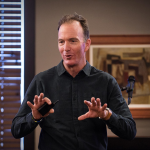Author: Douglas Kruger
On Culture and Leadership, WHAT COULD POSSIBLY BE SAFER THAN A RIGID RULE…? Can debate produce greater safety than rules? Isn’t the iron-clad rule a surer safeguard against disaster? We tend to think of organisations like NASA as having more or less the same basic character despite the passage of years. But it’s not necessarily […]
On Culture and Leadership, WHAT COULD POSSIBLY BE SAFER THAN A RIGID RULE…?
Can debate produce greater safety than rules? Isn’t the iron-clad rule a surer safeguard against disaster?
We tend to think of organisations like NASA as having more or less the same basic character despite the passage of years. But it’s not necessarily so. All organisations accumulate rules over time, and when left unchecked, these rules can fundamentally alter the nature of any organisation.
When NASA faced two separate, well-known challenges, their culture at each stage was very different.
In 1970, Apollo 13 was two days into its mission. While the astronauts on board hurtled towards the moon at 2 000 miles per hour, an explosion knocked out one of their oxygen tanks, leading Commander James Lovell to utter the now iconic statement, ‘Houston, we have a problem.’
The ensuing creative scramble to get the astronauts safely home is the stuff of legend. Just about everything that could go wrong did.
The creative trial and experimentation that went into rescuing the astronauts was formidable. New procedures were made up back on earth, then quickly tested in the simulator, then relayed to the astronauts 200 000 miles away, almost in real-time.
Yet through this process of creative trial and experimentation, of collaborative interdisciplinary debate, one by one the issues were resolved, and, ultimately, the crew was brought home safely.
…And here’s why:
At this point in time, NASA’s culture was ruled by imaginative debate. It was an exploratory culture, an experimenting culture, a culture based on learning and evolution, in which, every day, every new exercise and every new thing learnt was prodded and handed around like a toddler in a mommies’ group.
Even though the mission essentially failed, NASA nevertheless classified it as a ‘successful failure’, because of the experience gained and lessons learnt while rescuing the crew.
The alternative
By contrast, at the time of the Columbia disaster of 2003, the culture of experimentation had given way to one of formalised rules, regimented procedures and rigid hierarchy. One could argue that NASA had stopped being a learning organisation. It had become a bureaucracy instead.
As Columbia re-entered the earth’s atmosphere, a large piece of foam fell from the shuttle’s external tank and broke the wing of the spacecraft. First, atmospheric gasses entered the cabin, then the shuttle itself broke into pieces.
NASA recovered 84 000 pieces from a debris field of over 2 000 square miles.
The investigation into the disaster was exhaustive. Besides the physical cause of the accident, investigators made some damning remarks about the culture that led to the problem. Reliance on past success had become a substitute for true learning.
During a post-launch review, a group of engineers actually saw this foam dislodge from the rocket. They tried to pass on this information, and voiced their concern about it.
NASA’s management, which by this stage liked to manage everything ‘by the rules’, had seen dislodged foam before, and, according to their institutionalised perceptions, deemed it to be unimportant.
The engineers tried to argue that it seemed like a lot more foam than usual. It was a qualitative argument, based on human insight and intelligence. But NASA was unable to listen. The set-in-stone norms had it that dislodging foam was a known quantity, and the voices of the engineers went unheeded.
NASA by this stage was so bound in rules and procedures that, in important ways, it had ceased to be a learning, experimenting culture. Now it was an unheeding, process-following one. And that made it incapable of hearing an idea, to its great detriment.
Situational awareness:
The best and most agile organisations are not run by rigid rules. Instead, they favour imaginative debate. Encouraging imaginative debate allows situational awareness to pass up and down the chain of command. It promotes the opportunity to see innovation possibilities, and it becomes a safeguard against unexpected problems.
And so, a simple test: Which culture prevails in your organisation today? Imaginative debate? Or rigid rules? If it’s the latter, remember: They’re your rules. You can break them.
Douglas Kruger specialises in dismantling needless rules. A business speaker and author of 9 books with Penguin Random House, including ‘They’re Your Rules, Break Them!’, and the global publication, ‘Virus-Proof your Small Business.’ He speaks on leadership, culture, disruptive innovation and how to reduce your own rules for greater efficacy. Douglas is also a multiple award-winning speaker, who was inducted into the ‘Speakers Hall of Fame’ in 2016.
Contact Us at WeSpeak Global and follow us on Facebook
Author Profile
No results available
The articles, video and images embedded on these pages are from various speakers and talent.
These remain the property of its owner and are not affiliated with or endorsed by WeSpeak Global.

An interesting story of the emergence of Ferrero and Lessons Leading to Success, the famous world company with a turnover of more than 10 billion dollars, producing popular sweets and famous chocolate eggs with funny toys inside. It all started shortly after the end of World War II in a small provincial Italian town. Michele Ferrero […]

Change Your Sleep, Change Your Life: Do you suffer from the inability to go to sleep? I have my entire life. Until lately things have finally begun to change, but it is a choice, as I’ve begun to make and keep simple promises that are making a huge difference. Change Your Sleep, Change Your Life […]

An event in Costa Rica is known worldwide for its lush nature that attracts millions of tourists. Still, the country has diversified what it offers to stay current in an increasingly competitive international market, aiming to develop its appeal for corporate event production. This country has great potential due to its favorable geographical location, pleasant […]

I posted this about Hole in the Wall and Coffee Bay yesterday for Incredible Adventure Destinations . It’s a classic view of EsiKhaleni! This is a series of 9 episodes taking you on another Wild Journey into the heart of South African Adventure traveling. Follow explorer and adventurer Peter Van Kets and photographers, Jacques Marais, […]

Robyn Benincasa on Building World Class Teams, one of the highest rated female athlete speakers, and her adventure racing teams have learned about building world class teams the hard way – by competing in and winning the world’s toughest ultra-endurance adventure races. She shares her lessons on ‘Building World Class Teams’ with Fortune 500 […]

How your company’s career page is deterring candidates from applying. Every employee at your company can make or break a customer’s experience. That’s why it’s so important to ensure employees not only understand your company’s story, but also how they fit into it. Why does your company exist? Is there alignment between your stated mission, vision, and […]

WIFU: What’s in it for you, to read this? If you are ‘time-poor’, and therefore don’t have time to read this article right now, then simply use the acronym: BOOST© to ask yourself five questions: B = Bed- Do you wake up refreshed? O = Oxygen- Do you get enough oxygen to your brain throughout […]

With COVID-19 impacting so hugely on us globally and most of us practicing social distancing with A sanity toolkit, the main psychological challenge that many of us face is anxiety. This might include worries about what will happen next in our own worlds and in the world at large, worries about our health or the […]
No results available
Our Mission
© All rights reserved 2025. Created using VOXEL THEME